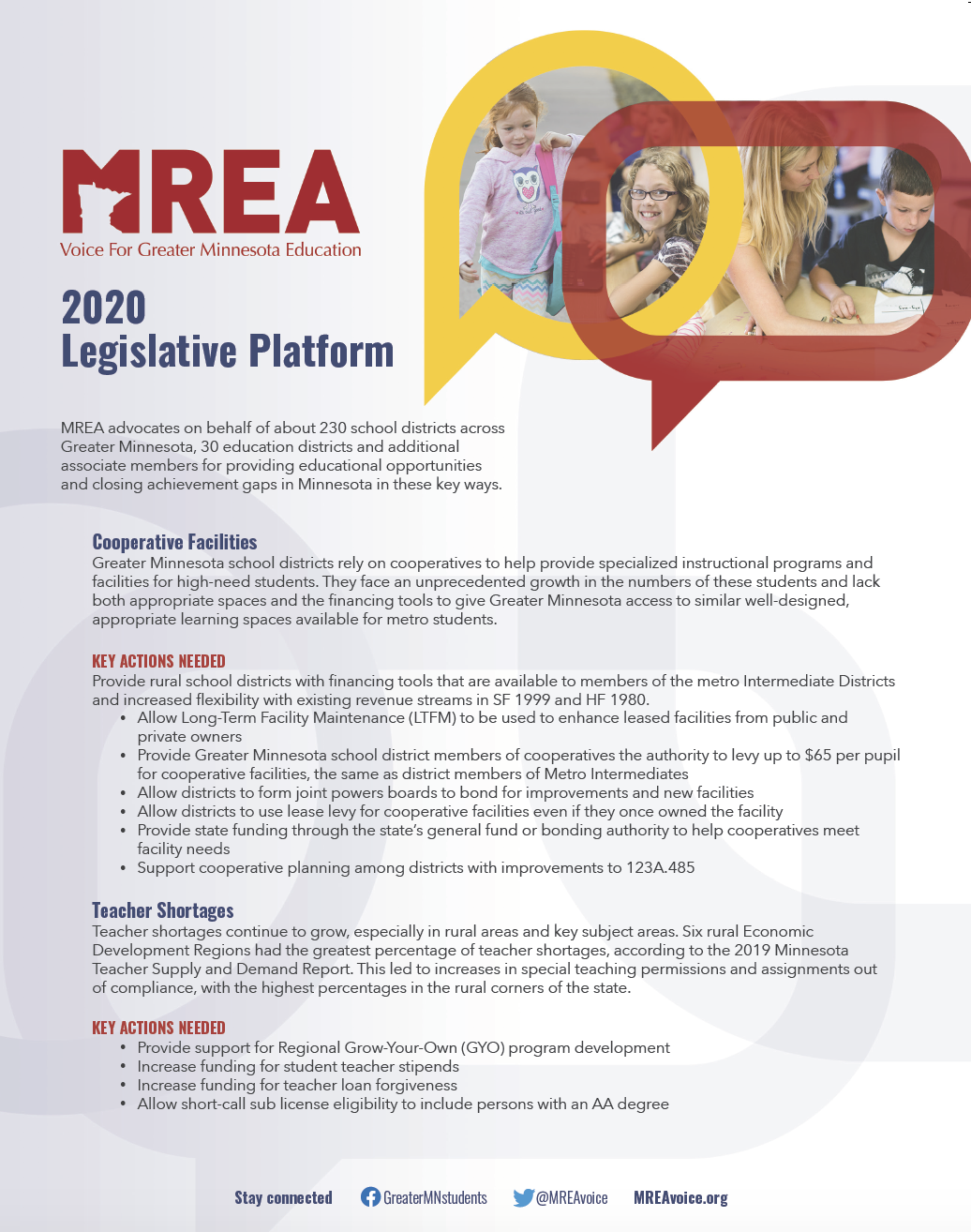Advocating for Greater Minnesota Education
MREA members support expanding educational opportunities and closing achievement gaps in Minnesota in the following ways. MREA’s membership includes about 230 school districts across Greater Minnesota, 30 education districts, special education and service cooperatives and additional associate members. Download the platform.
TEACHER SHORTAGES
Teacher shortages continue to grow, especially in rural areas and key subject areas. Six rural Economic Development Regions had the greatest percentage of teacher shortages, according to the 2019 Minnesota Teacher Supply and Demand Report. This led to increases in special teaching permissions and assignments out of compliance, with the highest percentages in the rural corners of the state.
Key Actions Needed
- Provide support for Regional Grow-Your-Own (GYO) program development
- Increase funding for student teacher stipends
- Increase funding for teacher loan forgiveness
- Allow short-call sub license eligibility to include persons with an AA degree
COOPERATIVE FACILITIES
Greater Minnesota school districts rely on cooperatives to help provide specialized instructional programs and facilities for high-need students. They face an unprecedented growth in the numbers of these students and lack both appropriate spaces and the financing tools to give Greater Minnesota access to similar well-designed, appropriate learning spaces available for metro students.
Key Actions Needed
Provide rural school districts with financing tools that are available to members of the metro Intermediate Districts and increased flexibility with existing revenue streams in SF 1999 and HF 1980.
- Allow Long-Term Facility Maintenance (LTFM) to be used to enhance leased facilities from public and private owners
- Provide Greater Minnesota school district members of cooperatives the authority to levy up to $65 per pupil for cooperative facilities, the same as district members of Metro Intermediates
- Allow districts to form joint powers boards to bond for improvements and new facilities
- Allow districts to use lease levy for cooperative facilities even if they once owned the facility
- Provide state funding through the state’s general fund or bonding authority to help cooperatives meet facility needs
- Support cooperative planning among districts with improvements to 123A.485
FUNDING STUDENT NEEDS
As state basic education funding continues to lag inflation, school districts have increasingly relied on voters for operating referendum revenue to fill the gap, which has grown to $661 since 2003. Referendums have passed at a higher rate for metro districts than those in Greater Minnesota.
Key Actions Needed
- Index the Tier II equalization factor to 85% of average RMV/RPU to equalize tax burdens in 225 mainly rural school districts
- Index the Tier I equalization factor to 125% of average RMV/RPU to equalize tax burdens in 281 districts
- Improve equalization of categorical aid formulas, including but not limited to: Safe Schools, Achievement and Integration, Operating Capital
- Provide a community viability option for districts below 1,000 APU by removing their referendum cap
HEALTHY, SAFE SCHOOLS & YOUTH
 Mental health needs, the dramatic increase in youth vaping and other chemical health issues are negatively impacting youth. These need to be addressed to create safe educational environments.
Mental health needs, the dramatic increase in youth vaping and other chemical health issues are negatively impacting youth. These need to be addressed to create safe educational environments.
More Minnesota students than ever report having long-term mental health, behavioral or emotional problems. Eleventh-grade female students who report having long-term mental health, behavioral or emotional problems has more than doubled from 2013 to 2019 and 24 percent report missing a full or partial day of school in the last 30 days because they felt very sad, hopeless, anxious, stressed or angry.
The tobacco and vape industry aggressively markets to youth and young adults. Almost 95 percent of addicted adult smokers start before age 21 and youth tobacco use is rising in Minnesota for the first time in 17 years, according to Clearway Minnesota.
Key Actions Needed
-
Increase funding for school linked mental health and innovative mental health grants
-
Raise the legal age to purchase all tobacco products and devices to 21 and require age ID for every purchase and delivery of tobacco products






